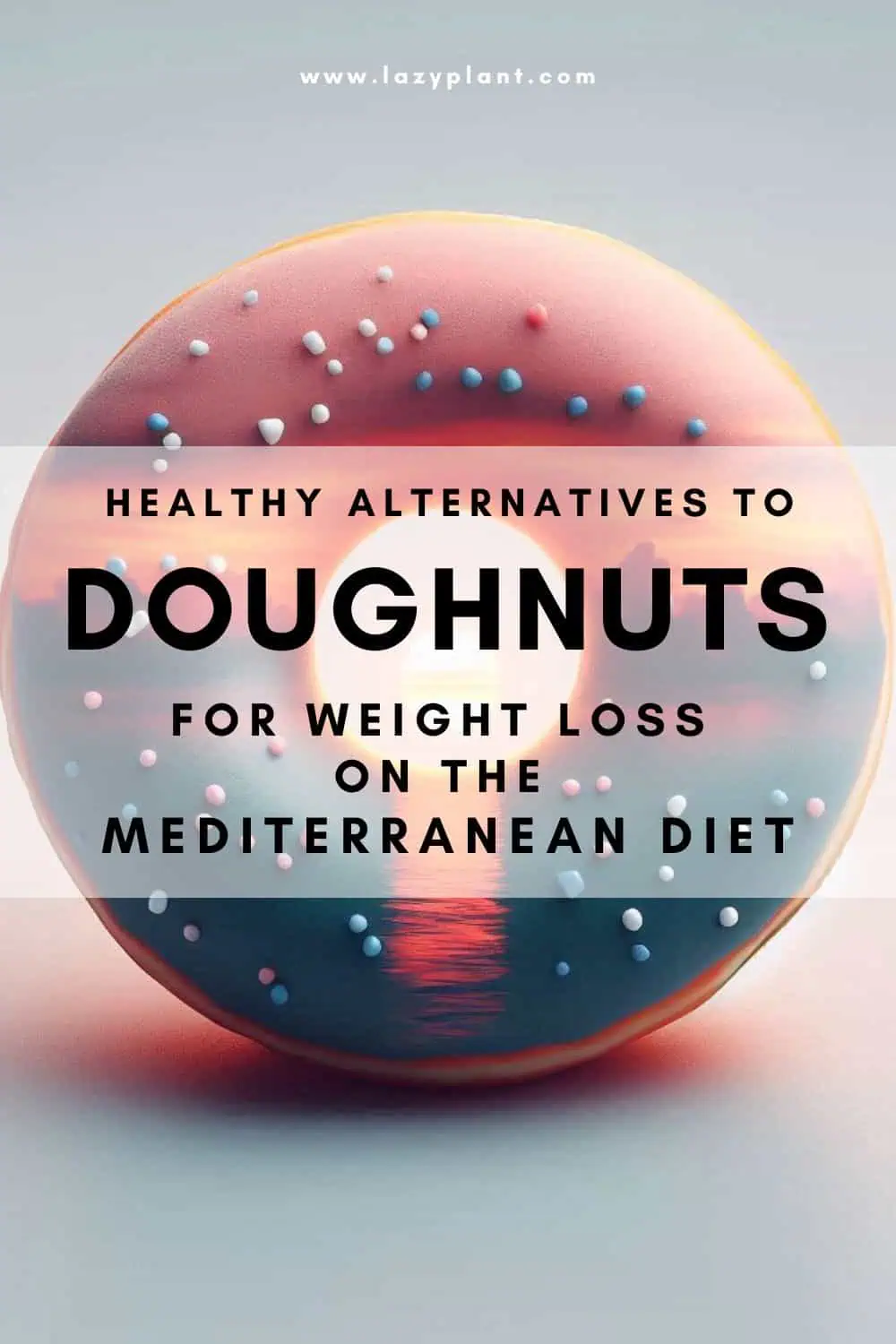A doughnut, with its high sugar, refined flour, and unhealthy fat content, is not typically part of the Mediterranean diet, especially for those looking to lose weight.
The Mediterranean diet focuses on whole, unprocessed foods like fruits, vegetables, whole grains, nuts, seeds, lean proteins, and healthy fats (especially olive oil). Eating doughnuts regularly would go against the core principles of this diet, which emphasizes moderation, nutrient density, and heart-healthy choices.
For weight loss or maintenance within the Mediterranean diet, it’s better to stick to natural, unprocessed sweets like fresh fruits, or occasional treats made with whole ingredients such as honey, nuts, or olive oil.
Sweets in the Mediterranean Region
In ancient Mediterranean civilizations like Greece, Rome, and Egypt, sweet treats did exist, but they were typically made from natural ingredients like honey, fruits, nuts, and occasionally flour. For example:
- The ancient Greeks and Romans enjoyed fried doughs drizzled with honey (similar to today’s loukoumades in Greece).
- Egyptians made desserts using dates, honey, and sesame seeds.
These sweets were much simpler than modern doughnuts and lacked the high levels of refined sugar and trans fats found in today’s pastries.

History of the Doughnut
The modern doughnut has its origins in Europe. Fried dough-like treats existed in many cultures, including medieval Europe, but the doughnut as we know it is thought to have been introduced by Dutch settlers in America. Originally called “olykoeks” (oily cakes), these early doughnuts were balls of dough fried in fat. Over time, the doughnut evolved into its ring shape and became popular as a sweet treat.[1]
In summary, while ancient Mediterranean civilizations did consume fried sweets, these were made from whole and natural ingredients.
If you are following the Mediterranean diet for weight loss or health, doughnuts should be consumed very sparingly, if at all, given their high sugar and fat content. Opt for traditional Mediterranean sweets or fresh fruit for a healthier alternative.
How much Sugar is in a Doughnut?
Doughnuts are particularly high in sugars, fats, and calories! A typical glazed doughnut (80g) contains about 340 calories, 15 grams of fats, and 28 g of sugars.[2]
Jelly and chocolate doughnuts are rich in calories, fats, and sugars as well, with a doughnut containing about 320 calories, 16 grams of fats, and 23 grams of sugars.
How much Sugar can we consume a day?
Excessive sugar consumption may be bad for health. It has been linked to obesity, type 2 diabetes, metabolic syndrome, inflammatory diseases, and cardiovascular disease. Also, too much sugar may lead to fat accumulation in the liver, decreased insulin sensitivity, increased uric acid and high cholesterol.[3]
The maximum safe intake of extra sugar is 5% of the consumed calories. So, people who follow a typical 2,000-calorie diet shouldn’t consume more than 25 grams of sugar a day. That’s the amount of sugar in a typical doughnut.
But, sugar is found everywhere. Extra sugar is added to sodas, sweets, and many other highly processed products.[4,5]
Cutting down on sugar isn’t easy. Sugar interferes with the reward system of the brain, affecting eating behavior and causing overeating. Also, excessive sugar consumption causes weight gain. It prevents the production of the leptin hormone. This hormone helps regulate energy balance by inhibiting hunger.[6]
Can people with Diabetes eat Doughnuts?
People with diabetes should avoid eating them as well. Doughnuts are packed with refined carbs, which spike blood sugar. According to the American Diabetes Association, people with diabetes should avoid eating refined, highly processed carbohydrate foods. Especially, those with added sugar.[7]
You better satisfy your sweet tooth by eating fruits like watermelon, strawberries, and pomegranates. Fruits are low in calories. Moreover, although they naturally contain sugars, they’re packed with vitamins, minerals, and other phytonutrients that prevent spikes of blood sugar.
Can I eat Doughnuts if I want to Lose Weight?
Doughnuts are pretty high in calories. You should avoid them if you want to lose weight. Eating doughnuts makes it difficult to be in a caloric deficit. Moreover, their high sugar content may cause food cravings. Just a doughnut may contain more sugar than the maximum safe intake!
What’s the best time to eat?
If you’re following the Mediterranean Diet and want to indulge in a doughnut, the best time to eat it would be earlier in the day, such as during breakfast or as a mid-morning snack. This allows your body to burn off the sugar and calories throughout the day when you’re more active, preventing a large spike in blood sugar closer to bedtime.
The worst time to eat a doughnut would be late in the evening or right before bed. Consuming a high-sugar, high-fat food like a doughnut late at night can lead to blood sugar spikes and excess calorie storage, which could hinder weight loss and disrupt sleep.
If you’re craving something sweet, it’s better to opt for a healthier Mediterranean alternative, like fresh fruit, yogurt with honey, or nuts, especially in the evening.
Alternative Traditional Mediterranean Sweets
Here are some traditional Mediterranean recipes for healthy sweets that can serve as excellent alternatives to doughnuts. They focus on whole, natural ingredients like honey, nuts, fruit, and olive oil, making them suitable for the Mediterranean diet and healthier for weight management.
Greek Yogurt with Honey and Walnuts
A classic, light dessert that’s rich in protein and healthy fats.
- Ingredients: Greek yogurt, honey, chopped walnuts, cinnamon (optional)
- Instructions:
- Place a serving of Greek yogurt in a bowl.
- Drizzle with honey.
- Top with chopped walnuts.
- Sprinkle cinnamon for added flavor.
Loukoumades (Greek Honey Dough Balls)
Though fried, this traditional Greek sweet uses minimal ingredients and is topped with honey and nuts. My favorite dessert…
- Ingredients: Flour, yeast, water, honey, cinnamon, chopped walnuts, olive oil for frying
- Instructions:
- Mix flour, yeast, and water into a dough and let it rise.
- Form small balls and fry in olive oil until golden.
- Drizzle with honey and sprinkle with cinnamon and chopped walnuts.
You’ll find Loukoumades mix on Amazon.
Dates Stuffed with Almonds
A simple, naturally sweet snack rich in fiber and healthy fats.
- Ingredients: Medjool dates, raw almonds
- Instructions:
- Pit the dates.
- Insert an almond inside each date.
- Optional: Dust with cinnamon or dip lightly in dark chocolate for extra flavor.
Citrus and Olive Oil Cake
A Mediterranean take on a cake using heart-healthy olive oil and citrus fruits.
- Ingredients: Whole wheat flour, olive oil, orange zest, lemon zest, eggs, honey or a natural sweetener
- Instructions:
- Mix flour, olive oil, citrus zest, eggs, and honey to form a batter.
- Pour into a cake pan and bake at 350°F (175°C) until golden and cooked through.
- Serve with a light dusting of powdered sugar or drizzle with extra honey.
Baklava with Nuts and Honey
This traditional Mediterranean dessert is rich, but when made with honey and nuts, it provides antioxidants and healthy fats.
- Ingredients: Phyllo dough, honey, chopped walnuts, almonds, or pistachios, cinnamon
- Instructions:
- Layer phyllo dough sheets with olive oil or butter, and chopped nuts mixed with cinnamon.
- Bake until golden and crispy.
- Drizzle with honey while still warm.
Fresh Fruit Salad with Honey and Mint
Simple and refreshing, this fruit salad can be customized with seasonal fruits.
- Ingredients: Mixed fruits (oranges, pomegranates, grapes, berries), honey, fresh mint
- Instructions:
- Chop a variety of fresh fruits.
- Drizzle with honey and mix gently.
- Garnish with chopped fresh mint leaves.

Fig and Almond Bars
These bars are nutrient-dense and naturally sweetened with figs, perfect for a quick snack.
- Ingredients: Dried figs, almonds, oats, honey, olive oil
- Instructions:
- Blend dried figs and almonds in a food processor.
- Mix with oats, honey, and olive oil.
- Press into a baking tray and bake at 350°F (175°C) for 15–20 minutes.
- Let cool and cut into bars.
Ricotta and Honey Tart
This light tart uses ricotta cheese and honey for a creamy and sweet dessert with fewer calories than traditional pastries.
- Ingredients: Ricotta cheese, honey, lemon zest, whole wheat tart crust, cinnamon
- Instructions:
- Mix ricotta cheese with honey and lemon zest.
- Spread the mixture into a pre-baked whole wheat tart crust.
- Bake at 350°F (175°C) for about 20 minutes.
- Let cool and sprinkle with cinnamon before serving.
Halva with Tahini and Honey
Halva is a traditional sweet made from tahini (sesame paste) and honey or sugar.
- Ingredients: Tahini, honey, pistachios, vanilla extract
- Instructions:
- Warm honey and mix it with tahini and vanilla extract.
- Stir in chopped pistachios.
- Pour into a mold and refrigerate until firm.
Tahini is probably the healthiest traditional Mediterranean spread you can enjoy daily!
These traditional Mediterranean desserts are not only delicious but also much healthier than doughnuts, with more nutrient-dense ingredients like fruits, nuts, and honey that align with the Mediterranean diet’s principles.